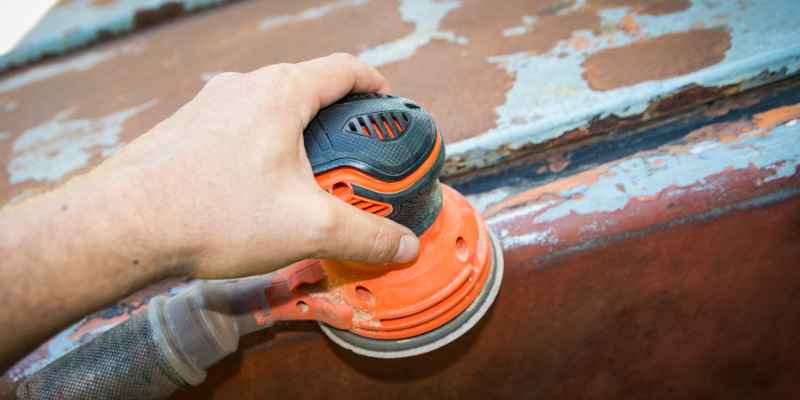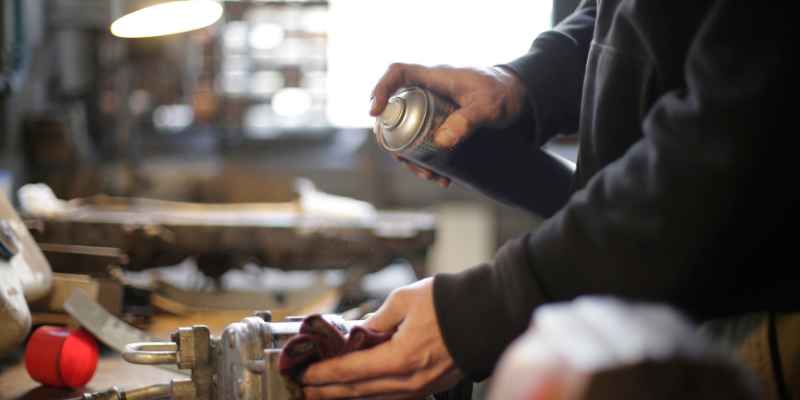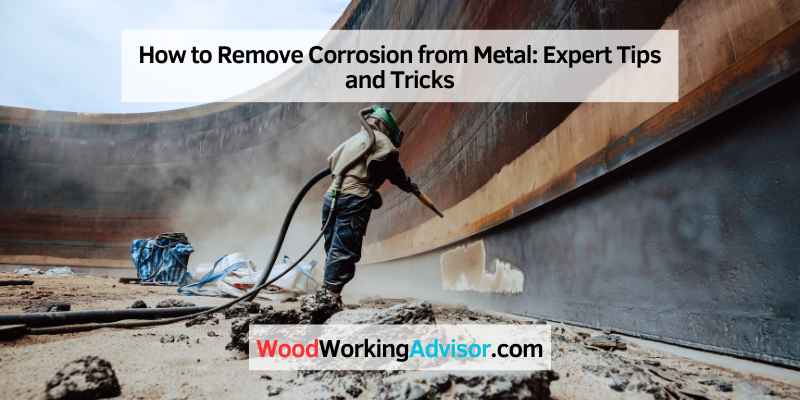To remove corrosion from metal, create a paste of baking soda and water. Apply and scrub the affected areas.
Corrosion on metal surfaces can be unsightly and cause damage over time. Removing it promptly is essential to prevent further deterioration. By following simple steps, you can effectively eliminate corrosion and restore the metal’s appearance. Whether it’s on outdoor furniture, tools, or household items, tackling corrosion promptly will prolong the life of your metal possessions.
Don’t let corrosion compromise the integrity of your items – take action to remove it promptly.
Prevention Methods
Prevention methods are essential in maintaining metal items and preventing corrosion. By following some key practices, you can prolong the life of your metal objects and prevent corrosion from occurring.
Proper Storage Techniques
Proper storage helps in preventing moisture exposure, a common cause of corrosion on metal surfaces. Store metal items in a dry place away from humidity.
Use Of Protective Coatings
Applying protective coatings acts as a barrier against moisture and other elements that can lead to corrosion. Consider using paint, varnish or wax as protective coatings on metal surfaces.

Common Household Remedies
The presence of corrosion on metal surfaces can be unsightly and damaging. However, you don’t need to rush to the store for expensive commercial products to remove this stubborn problem. In fact, you may already have effective solutions for removing corrosion right in your own household. Here are two common household remedies that can help you tackle corrosion: vinegar and baking soda solution, and lemon juice and salt paste.
Vinegar And Baking Soda Solution
One of the most popular and effective remedies for removing corrosion is a simple solution made from vinegar and baking soda. Vinegar contains a mild acid that can help dissolve the corrosion, while baking soda acts as an abrasive to gently scrub away the rusted layers.
To create this solution, you will need:
| Vinegar | Baking Soda | Bowl or container | Sponge or soft cloth |
- Mix equal parts of vinegar and baking soda in a bowl or container.
- The mixture may fizz, so give it a moment to settle.
- Dip a sponge or soft cloth into the solution, making sure it is well saturated.
- Gently scrub the corroded metal surface with the sponge or cloth, applying pressure as needed.
- Rinse the metal surface with water and dry it thoroughly.
Remember to wear protective gloves to avoid direct contact with the vinegar solution, as it can irritate your skin.
Lemon Juice And Salt Paste
An alternative household remedy for removing corrosion involves the use of lemon juice and salt. Both lemon juice and salt contain properties that can help dissolve and lift the corrosion, restoring the metal surface to its original shine.
To create this paste, you will need:
| Lemon juice | Salt | Bowl or container | Brush or sponge |
- Squeeze enough lemon juice to cover the corroded area into a bowl or container.
- Add a generous amount of salt to the lemon juice to create a thick paste.
- Stir the mixture until the salt is well combined with the lemon juice.
- Apply the paste directly onto the corroded metal surface, making sure to cover all affected areas.
- Leave the paste on the metal surface for about 15-30 minutes to allow the lemon juice and salt to work their magic.
- After the recommended time, scrub the corroded surface with a brush or sponge, applying gentle pressure.
- Rinse the metal surface with water and dry it thoroughly.
Both of these household remedies can be effective in removing corrosion from metal surfaces. Give them a try before resorting to costly commercial products and see the difference they can make!
Chemical Solutions
When it comes to removing corrosion from metal, chemical solutions can be an effective and efficient method. There are various chemical treatments that can effectively dissolve and remove corrosion from metal surfaces. Below are some popular chemical solutions to tackle corrosion on metal:
Phosphoric Acid-based Cleaners
Phosphoric acid-based cleaners are potent solutions for removing rust and corrosion from metal surfaces. They work by chemically converting iron oxide (rust) into a form that can be easily rinsed away, leaving behind a clean metal surface.
Oxalic Acid Treatment
Oxalic acid is another effective chemical treatment for corroded metals. It works by forming a water-soluble complex with metal ions, making it easier to remove the corrosion. Oxalic acid can be applied as a solution or in the form of gel, effectively restoring the metal’s surface to its original state.
Mechanical Methods
Start of blog content
When dealing with stubborn corrosion on metal surfaces, utilizing mechanical methods can be an effective way to restore the metal’s integrity and prolong its lifespan. Mechanical techniques involve physically removing the corroded layers through various means, such as wire brushes and sandblasting. These methods are excellent for addressing heavy corrosion and are often preferred for their ability to strip the metal down to a clean, bare surface.
Using Wire Brushes
To start with the mechanical removal of corrosion, wire brushes prove to be valuable tools. These brushes come in various sizes and compositions, including steel, brass, and nylon. The stiff and abrasive nature of wire brushes facilitates the elimination of corrosion from metal surfaces. By vigorously scrubbing the affected area with a wire brush, the loose and flaky corroded material can be effectively dislodged, revealing a smoother, cleaner metal surface underneath.
Sandblasting Techniques
Another prominent mechanical method for corrosion removal is sandblasting. This process involves propelling fine granules at high pressure to erode away surface contaminants, including corrosion. Sandblasting provides a thorough and uniform removal of corrosion from metal, leaving behind a clean and properly prepared surface. Whether through the use of abrasive sand or other media types, this technique is capable of restoring metal components to their original condition.
End of blog content
Electrolysis Process
Electrolysis is an effective process to remove corrosion from metal. By applying an electric current, the rust is essentially dissolved, leaving the metal surface clean and revitalized. This method is proven to be a reliable solution for restoring metal objects to their original state.
Understanding Electrolysis
If you’re searching for an effective way to remove corrosion from metal, electrolysis is a process that you shouldn’t overlook. Electrolysis is a chemical reaction that uses an electric current to break down compounds and remove rust and corrosion from metal surfaces. By harnessing the power of electricity, you can restore your metal items to their former glory.
Steps For Implementing Electrolysis
If you’re ready to give electrolysis a try, the following steps will guide you through the process.
- Step 1: Gather the necessary materials. For electrolysis, you’ll need a container, such as a plastic bucket or tub, that can hold both your metal item and the electrolyte solution. You’ll also need a power supply, such as a battery charger or a rectifier, to provide the electric current. Additionally, you’ll need a sacrificial electrode (made of a compatible metal) and a non-conductive material like plastic or wood to suspend your metal item in the electrolyte solution.
- Step 2: Create the electrolyte solution. The electrolyte solution helps facilitate the electrolysis process. You can make a solution using hot water and a suitable electrolyte, such as baking soda or washing soda. The exact measurements may vary depending on the size of your container, so it’s important to follow the recommended ratios from reliable sources.
- Step 3: Set up the electrolysis system. Place your container in a well-ventilated area and ensure that all the components are properly connected. Attach the positive electrode (anode) to your metal item and the negative electrode (cathode) to the sacrificial electrode, making sure they don’t touch each other or the container. Position them in a way that allows for even distribution of the electric current.
- Step 4: Submerge and start the process. Carefully lower your metal item into the electrolyte solution so that it’s fully submerged but not touching the container’s sides or bottom. Turn on the power supply, and you’ll see bubbles forming on the metal surface as the corrosive rust is being converted back to metal.
- Step 5: Monitor the progress and clean the item. Allow the electrolysis process to continue for an appropriate length of time, depending on the severity of the corrosion. Regularly inspect the metal item to track its progress. Once you’re satisfied, turn off the power supply, remove the item from the electrolyte solution, and scrub away any remaining debris using a non-abrasive brush or sponge. Rinse the item with clean water and dry thoroughly.
By following these simple steps, you can successfully implement the electrolysis process and remove corrosion from your metal items. Say goodbye to rust and hello to renewed shine!

Professional Help
When To Seek Professional Assistance
In certain cases, corrosion on metal surfaces may require professional intervention.
- If the corrosion is severe or covers a large area, professional help is recommended.
- When complex restoration techniques are necessary, it’s best to contact a professional.
Choosing The Right Metal Restoration Expert
Finding the right metal restoration expert is crucial for effective corrosion removal.
| Considerations | Tips |
|---|---|
| Experience | Look for professionals with extensive experience in metal restoration. |
| References | Check customer reviews and ask for references to ensure credibility. |
| Expertise | Choose specialists in the type of metal you need restored. |
Final Tips And Recommendations
In need of tips to remove corrosion from metal? Here are some final recommendations. Remember to use appropriate solutions and gentle scrubbing techniques to effectively restore the metal’s condition without causing further damage.
Maintaining your metal surfaces is crucial in preventing corrosion and ensuring long-lasting durability. Take note of these key tips and recommendations to keep your metal free from corrosion.
Regular Maintenance Practices
Implement routine inspections to identify any signs of corrosion early on. Clean metal surfaces regularly to remove dirt and debris that can accelerate corrosion. Apply a protective coating to seal the metal and prevent oxidation.
Selecting The Appropriate Corrosion-resistant Materials
Choose high-quality materials such as stainless steel or galvanized metal for projects exposed to moisture and humidity. Opt for aluminum or zinc coatings for enhanced corrosion resistance in outdoor environments.
Frequently Asked Questions Of How To Remove Corrosion From Metal
How Does Corrosion Affect Metal?
Corrosion can cause metal to weaken, discolor, or become brittle, leading to structural damage and reduced lifespan. It’s important to address corrosion promptly to prevent further deterioration.
What Are Common Methods To Remove Metal Corrosion?
Using abrasive tools like sandpaper or wire brushes, chemical treatments such as vinegar or rust removers, and electrolysis are popular options for removing metal corrosion.
Is It Possible To Prevent Future Metal Corrosion?
Yes, applying protective coatings, regular cleaning and maintenance, and storing metal items in dry, controlled environments can help prevent future corrosion and prolong the life of the metal.
Conclusion
Removing corrosion from metal is a straightforward process that can be accomplished using various methods. By utilizing household items like vinegar or baking soda, or commercial rust removers, you can effectively restore the metal’s appearance and prevent further damage. Remember to take safety precautions, such as wearing gloves and protective eyewear, when handling corrosive substances.
Maintaining regular cleaning and maintenance routines will help prolong the lifespan of your metal belongings. Follow these tips, and say goodbye to unsightly corrosion for good.


